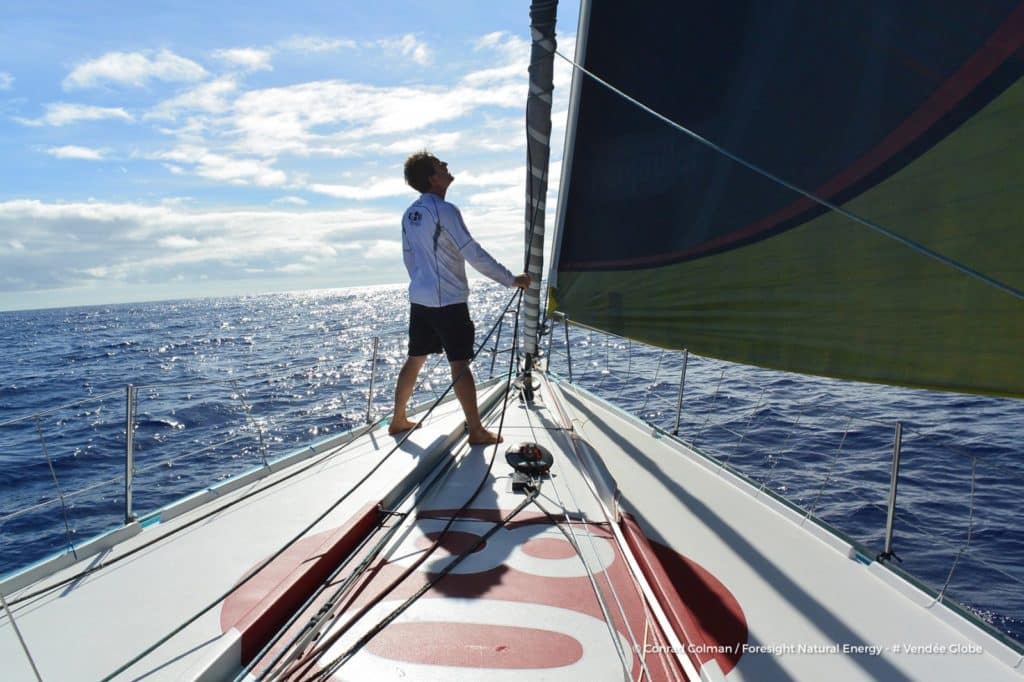
The group in front are racing to keep ahead of the front. Morgan Lagravière can see it creeping up behind him. Further back, there’s not a lot that can be done except enjoy the weather, as the wind is playing hide and seek, as Stéphane Le Diraison told us. At the rear, Catalan sailor Didac Costa’s problem was dealing with seaweed.
Morgan Lagravière (Safran): “We’re in a race trying to get as far to the SE as we can, trying to find strong winds and a good angle. In this situation, the further in front you are, the faster you are. All of our group took advantage to step up the pace and get away from those chasing us. Vincent (Riou) and Jérém (Beyou) got overtaken by the front. Staying ahead of the front meant getting the best angle. Behind it, the seas are rough. But surprisingly even ahead of the front it wasn’t that pleasant. It’s hard to get 100% out of these boats. But at least it’s better than for those behind who are slamming into the seas.”
Didac Costa (One Planet One Ocean): “The Southerly wind – precursor of the SE trade winds that mark the end of the Doldrums – arrived last night. Before, during the day and the first part of the night, it was difficult to gain nm with very light winds and isolated squalls. During a period of calm I took the opportunity to dive and remove the remainder of the seaweed that was wrapped around the propeller. We had crossed an area with a lot of seaweed the day before. To remove those that are hooked on the rudders; I use a blade with a thin rope and a lead at its end. I get on quite well thanks to a technique that we developed with Aleix during the Barcelona World Race, but when they get caught in the propeller, there is no other choice than to furl the headsail, get into irons and try to go backwards. I had to do it a couple of times because, with the seaweed hooked up, the vibration transmitted to the engine is considerable and quite disturbing. The second time I did it, the seaweed did not completely disappear and I started wondering if it had been doing that noise before and had not noticed, if it was normal or not normal, etc. When I dived, I took the last piece of seaweed off and both the noise and the worry disappeared. With the sheets well trimmed and the new wind gradually strengthening we should be crossing the Equator sooner than later and so changing hemispheres. Les Sables d’Olonne is a long way away! I am starting to have a look at the positions reports more often and, although the distance to the boats ahead is enormous and the wind conditions are different, it is encouraging to see that you gain some miles on the others; it motivates you to push the boat even more and try to get the best performance out of her.”
Stéphane Le Diraison (Compagnie du Lit – Boulogne Billancourt): “The strategy today is very complicated. The group in front got around the high. We’ve got a huge ridge of high pressure without any wind. So we have the choice of trying to get around the sides or waiting for the system to move off. So for the moment we’re going along this ridge hoping it will move south, so we don’t get caught in it. The good thing is the weather is fine, but on the other hand, we’re not making any progress. We won’t be getting any new wind for 48 hours. Then there’s a second high moving eastwards, which could be another hurdle for us. We’re not likely to se any real wind until the end of the week. For 48 hours I was alongside Conrad Colman, whom I have known for a long time. He was my pacemaker there. My boat is better suited to stronger winds. We went our own way this morning. I got ten or twenty miles or so in front.”









